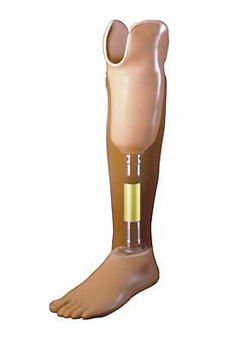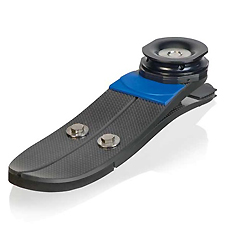 The loss of a lower limb deeply influences a person’s ability to move for the rest of his/her life. The prosthetics programme for lower limbs is meant to recover mobility by combining a range of state-of-the-art components with a comfortable socket. Of key importance to the successful use of the lower limb prosthesis is the fitting of the socket. We know that precisely the comfort of the socket is decisive and if it is uncomfortable, one would not be wearing the prosthesis. It is for this very reason that that the sockets are custom-made, for every individual designed according to the outlines of the bones and the muscles of the stump of the patient.
The loss of a lower limb deeply influences a person’s ability to move for the rest of his/her life. The prosthetics programme for lower limbs is meant to recover mobility by combining a range of state-of-the-art components with a comfortable socket. Of key importance to the successful use of the lower limb prosthesis is the fitting of the socket. We know that precisely the comfort of the socket is decisive and if it is uncomfortable, one would not be wearing the prosthesis. It is for this very reason that that the sockets are custom-made, for every individual designed according to the outlines of the bones and the muscles of the stump of the patient. The new materials such as polyurethane, sockets of mineral composition and silicon with improved qualities, are much more flexible than the solid plastic materials used in the past. People of all ages could wear comfortable, flexible and light prostheses.
More than two thirds of people who undergo a lower limb amputation are older people. The comfortable socket, taking into account the anatomical lines is equally important for the 70 or 80-year old patient and for the teenager. The anatomical lines not only work in conjunction with the anatomic structure of the person to assist the right transmission of force and pressure through the prosthesis to the ground, but they also increase the level of comfort. After decades of work in the area of socket design for hip, above-the-knee and other types of lower-limb prostheses, the most successful forms and designs are achieved by following the anatomical lines and the particularities of the bones, muscles, tendons and nerves. As a result of this development, people using prostheses can already take part in activities and occupations that they previously considered impossible.
Above-the-Knee Prosthesis
 The above-the-knee prosthesis consists of a custom-made socket on basis of individual cast, a knee module, a pylon support part and a foot.
The above-the-knee prosthesis consists of a custom-made socket on basis of individual cast, a knee module, a pylon support part and a foot.
Sometimes a liner could also be necessary for the attachment. Although each individual case is different, the process of fitting the prosthesis of people with recent limb amputations usually starts several weeks following the surgery. The prosthetic process starts with the design of an interim or test socket of transparent thermoplastic material. The interim prosthesis usually does not have a cosmetic cover, so that it is easier for the Prosthetic technician to make corrections along the prosthesis and in the knee area. People usually begin with physiotherapy, exercise and gait training while they wear the interim prosthesis. During this period, it is most important to identify all places sensitive to touching or abrasion of the stump and to take the necessary action. When the size of the stump becomes stable and the patient develops a sustainable level of activity, usually it is time to put on the final prosthesis.
Hip prostheses can be classified in three main categories according to the socket:
- With a laminated vacuum socket
- With an internal silicon liner and an external laminated socket
- With an internal flexible liner of thermoplastic copolymers (gel liner) and an external carbon framework socket
Below-the-knee Prosthesis
 The below-the-knee prosthesis usually consists of a custom-made socket on basis of individual cast, a knee module, a pylon support part and a foot. Although each individual case is different, the process of fitting the prosthesis of people with recent limb amputations usually starts several weeks following the surgery. The use of a temporary prosthesis has multiple advantages. It allows the swelling to decrease and the sump to heal completely. Between the sock and the stump, a prosthetic or a protective sock is to be worn, along with a soothing gel, in order to protect the sensitive skin of the stump. The size of the stump decreases with each day and the patient can add additional layers of prosthetic socks, so the socket does not become too loose. If the socket becomes too loose, a new socket is made to reflect the changes in the size of the limb. The pylon-type support part of the interim prosthesis usually does not have a cosmetic cover, so that it is easier for the Prosthetic technician to make corrections to the prosthesis. People usually begin with physiotherapy, exercise and gait training while they wear the interim prosthesis. During this period, it is most important to identify all places sensitive to touching or abrasion of the stump and to take the necessary action. When the size of the stump becomes stable and the patient develops a sustainable level of activity, usually it is time to put on the final prosthesis.
The below-the-knee prosthesis usually consists of a custom-made socket on basis of individual cast, a knee module, a pylon support part and a foot. Although each individual case is different, the process of fitting the prosthesis of people with recent limb amputations usually starts several weeks following the surgery. The use of a temporary prosthesis has multiple advantages. It allows the swelling to decrease and the sump to heal completely. Between the sock and the stump, a prosthetic or a protective sock is to be worn, along with a soothing gel, in order to protect the sensitive skin of the stump. The size of the stump decreases with each day and the patient can add additional layers of prosthetic socks, so the socket does not become too loose. If the socket becomes too loose, a new socket is made to reflect the changes in the size of the limb. The pylon-type support part of the interim prosthesis usually does not have a cosmetic cover, so that it is easier for the Prosthetic technician to make corrections to the prosthesis. People usually begin with physiotherapy, exercise and gait training while they wear the interim prosthesis. During this period, it is most important to identify all places sensitive to touching or abrasion of the stump and to take the necessary action. When the size of the stump becomes stable and the patient develops a sustainable level of activity, usually it is time to put on the final prosthesis.
The below-the-knee prostheses are usually of two types:
- With an internal soft liner of polyform or other thermoplastic material, which envelopes the stump and steps into the external hard socket of laminated resin with carbon support.
- With an internal polyurethane or silicon liner, which is attached to the external laminated socket with a latch.
Prosthesis for hip disarticulation
 The prostheses for hip disarticulation or hemipelvectomy usually consists of a custom-made socket on basis of individual cast, a hip joint, a rotator, a knee module, a support pylon-type part, a pylon-type support part and a foot.
The prostheses for hip disarticulation or hemipelvectomy usually consists of a custom-made socket on basis of individual cast, a hip joint, a rotator, a knee module, a support pylon-type part, a pylon-type support part and a foot.The socket envelopes the amputated side of the body and also envelopes the healthy part of the core and the bottom of the patient. The skilled casting/measurement of the residual hip or pelvic bone is the first most important step in the prosthetic process.
The high-level amputations such as hip disarticulation or hemipelvectomy could be a difficult challenge for the fitting and putting on of the prosthesis. The full loss of the foot, ankle, knee and hip make it much harder for patients to reach a level of comfort and stability.
Walking with this type of prosthesis could also require twice as much energy than normal walking.
Some people with a hip disarticulation or hemipelvectomy are discouraged from using a prosthetic leg by good-intentioned medical specialists and family members. Others might have tried to wear a prosthetic leg and in a moment of dissatisfaction or helplessness have decided that they could be more mobile while using crutches or a wheelchair.
The challenges associated with learning how to use a prosthesis in the cases of hip disarticulation or hemipelvectomy require an additional level of perseverance and consistency on behalf of the patient, the prosthetic technician and the physiotherapist.
Usually, several months of physiotherapy and daily use of the prosthesis are necessary for the patient to start feeling independent and confident.
"Syme" Prosthesis
 A Syme amputation is a disarticulation of the ankle (removal of the foot via the ankle joint) where the malleoles (the two protuberances on both sides of the ankle) are removed and then a front rotation of the heel is made on the remaining tibia bone. Very different views exist on the benefits of the Syme-method amputation. Some people with a Syme-type amputation have difficulties wearing a prosthesis, others do very well. The hard socket plays an important role in the fitting of the prosthesis in the Syme amputation cases.
A Syme amputation is a disarticulation of the ankle (removal of the foot via the ankle joint) where the malleoles (the two protuberances on both sides of the ankle) are removed and then a front rotation of the heel is made on the remaining tibia bone. Very different views exist on the benefits of the Syme-method amputation. Some people with a Syme-type amputation have difficulties wearing a prosthesis, others do very well. The hard socket plays an important role in the fitting of the prosthesis in the Syme amputation cases. The socket has a soft internal socket and usually extends a little below the knee.
Other types of socket design that is sometimes used includes the “Canadian Syme”.
 The “Canadian Syme” has an opening in the back to put on the socket more easily. The short distance between the end of the stump and ground means that standard prosthetic feet usually need to be modified for their proper fitting and fixing. Among the options is the “Sach” foot (with a solid ankle, i.e. without movement in the ankle, and a reinforced foot) or an energy-saving foot, reinforced by carbon fibres.
The “Canadian Syme” has an opening in the back to put on the socket more easily. The short distance between the end of the stump and ground means that standard prosthetic feet usually need to be modified for their proper fitting and fixing. Among the options is the “Sach” foot (with a solid ankle, i.e. without movement in the ankle, and a reinforced foot) or an energy-saving foot, reinforced by carbon fibres.
Partial Foot Amputations
Partial Foot Amputations include:- Amputation of a toe
- A Hemi-foot Amputation (amputation via the metatarsophalangeal join and via the metatarsal joint)
- Lisfranc or Chopart amputations of the foot.
The prosthetic options include:
- Not wearing a prosthesis;
- A static foot with an orthopaedic shoe insert to support the arch of the foot, in conjunction with a shoe with ends curved up at the toes and heel.
- Custom-made orthesis/prosthesis for the foot designed on basis of individual cast;
- Custom-made orthopaedic shoes;
- A modified ankle-foot orthesis with a filling in the missing toe;
- A foot prosthesis (with a custom-made socket attached to the semi-mobile foot with filling of the missing toe).



